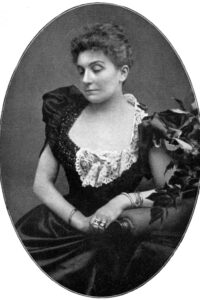
The Mystery of a Turkish Bath
These garments were so hideous, she told herself, that it was no wonder people looked like such guys in them. Still, there was no reason she should not have something chic and novel for herself—something which should arouse envy and make the wearer appear quite different from the other women. The choice of style was easy enough—something Grecian and artistic—but the material discomposed her. It was hardly possible to have a bath of this description without one’s garment getting into a moist and clinging condition—leaving alone the after processes of shampooing, douching, and plunging.
So silk, satin, or woollen material was out of the question, and cotton was standard, not to say vulgar. She knitted her brows with a vigour demanded by so absorbing a subject: the white head-cloth fell off, and she felt that her fringe was all out of the curl and lay straight on her forehead in the most unbecoming fashion. That also would have to be considered in the costume question—a headdress that should combine use and ornament. The idea of having only a wet, white rag on one’s head! No wonder people looked “objects!”
Perhaps it would be better to coil the hair about the brow and have no fringe or at least a few loose locks that would look equally well, straight or curled. As Mrs Ray Jefferson was taking all this trouble about her appearance when that appearance would only gratify the sight of a few members of her sex who were generally too much taken up with their ailments or complaints to care what their fellow sufferers looked like, it shows the fallacy of a popular superstition that women only care to dress for men.
Read or download Book
Eliza Margaret Gollan
Eliza Margaret Jane Gollan was born at Gollanfield in Inverness-shire, the daughter of John Gilbert Gollan, a Scottish businessman, and his wife Jane Plumb, daughter of the manager of the Bank of Bengal.
Biography.
Her father travelled extensively, visiting India and Australia, and became a landowner in Scotland after inheriting the family home at Gollanfield. This necessitated the family’s move from India to Scotland to take ownership. Eliza Gollan was born on 14 June 1850 on the family estate as the second of three children. The family then moved to Sydney, Australia, where her father had business interests, and she was raised and home-educated there.
However, the business venture turned out disappointingly, and the family returned to London when Gollan turned 14. Eliza received little formal education, but her storytelling talent was apparent early. She used her experience of Australia to write a semi-autobiographical novel, Sheba, in 1889, using the pen name ‘Rita’. Another book, Episodes, was originally published using the pen name ‘E. Jayne Gilbert.’ Eliza was married twice. On 23 July 1872, aged just 22, she married Karl Otto Edmund Booth, a musician, with whom she had three sons. This unhappy marriage later provided Eliza with material for four novels: Saba Macdonald (1906), The Grandmothers (1927), The Wand’ring Darling (1928), and Jean and Jeanette (1929).
The marriage to Booth ended, but the author went on to a happy union with Anglo-Irish singer William Humphreys, with whom she had a daughter. Humphreys used the stage name Desmond Humphreys, and after their marriage, Eliza was known as Mrs. W. Desmond Humphreys. Eliza spent her married life in Cork, Ireland, Bournemouth and Bath, Somerset. In 1910, she was listed as one of the celebrities of Bournemouth, with books published in French, German, and Italian; at the time, she was undertaking a tour of America.
The dedication in the first edition of Saba Macdonald reads: To “THE EMANACIPATED WOMAN” who owes her present freedom of mind, morals, and pastimes to such repression and tyranny as formed the discipline of youth in days such as this book commemorates.






